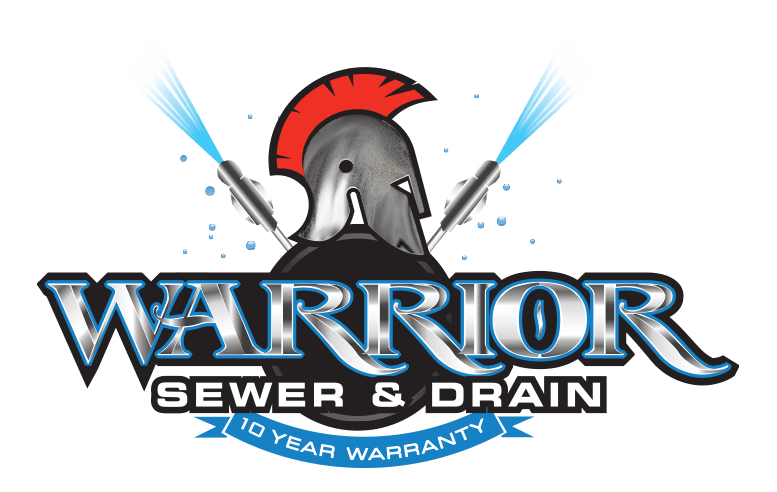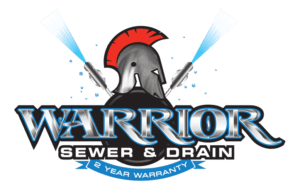Battle Against the Clog: The Ultimate Guide to Unclogging Your Shower Drain
Has your relaxing shower ever turned into an unplanned foot bath due to a clogged drain or sewer line? If so, you’re not alone and you may be interested in DIY shower drain unclogging before using drain cleaning services.
Many of us have experienced the annoyance of a blocked shower floor drain because we avoid drain cleaning. But don’t fret, we’re here to help!
Warrior Sewer and Drain is here to provide you with the best professional drain cleaning services and clogged drain information for all your sewer and plumbing problems at home.
Here is your ultimate, detailed drain cleaning guide to four do-it-yourself strategies that will leave your shower drain pipe clear and flowing freely.
1. Homage to the Humble Plunger: A Time-Honored Solution
The first tool we’re pulling from our DIY arsenal is a sewer cleaning classic: the plunger. While it may not seem like the most sophisticated tool, don’t underestimate its power over a clogged drain.
Plunging Into Success
Before you begin your quest to conquer the clogged drain and evade a plumbing company, it’s important to understand how to effectively use a plunger. This simple yet mighty tool relies on the power of suction to dislodge clogs and get the water flowing once more.
Here’s your step-by-step guide:
– Step 1: Before you begin plunging, make sure to clear any visible blockages from the surface of the clogged drain. Don a pair of rubber gloves and remove any hair or debris. These tools are essential during drain cleaning. This might not be the most pleasant task, but it’s a crucial first step towards unclogging your drain.
– Step 2: Once the surface debris is gone, it’s time to prepare for plunging. Fill the shower with enough water to fully submerge the base of the plunger. This is important because it is the water, not air, that creates the pressure necessary to dislodge the clog.
– Step 3: Now comes the real action! Place the plunger over the drain and start plunging vigorously, using both downward and upward movements. Consider it a mini upper body workout!
Keep in mind, though, that while a plunger is a great first line of defense for drain cleaning, it might not be able to take on more stubborn clogs. For those, we have more tools in our DIY plumbing company toolkit.
2. The Snake and Wire Hanger: Unseen Heroes of DIY Shower Floor Drain Unclogging
Meet your next sewer line secret weapons: the plumber’s snake and the wire coat hanger. Although these tools may seem primitive, they are incredibly effective for those hard-to-reach drain clogs that plunging alone can’t tackle.
Snaking Your Way to a Clear Drain
– Step 1: If you’re using a wire hanger, you’ll need to unwind it until it’s straight, leaving the hook at one end. If you’re using a plumber’s snake, you’re immediately ready to go get started on your drain cleaning.
– Step 2: Next, slowly push the snake or hanger down the drain until you feel resistance, which is likely the clog.
– Step 3: Once you’ve located the clog, it’s time to get to work. Twist the snake or hanger and then pull it back up, aiming to bring the clog up with it.
The snake and wire hanger are great tools to have in your drain unclogging arsenal, but sometimes, a different approach is needed during drain cleaning. In those cases, it’s time to turn to a little clogged drain cleaning science.
3. The Dynamic Duo: Baking Soda and Vinegar
While there are many drain cleaning chemical cleaners on the market, they can be harsh and damaging to your pipes. A safer, more eco-friendly option is the combination of baking soda and vinegar, two household staples that together create a potent drain cleaning solution.
Creating a Volcanic Reaction in Your Drain
– Step 1: Start by pouring a cup of baking soda down the drain. This will serve as the base of your homemade drain cleaner.
– Step 2: Next, pour a cup of vinegar down the drain. When combined with baking soda, it creates a fizzing reaction that can break up the clog.
– Step 3: Wait for about 20-30 minutes to allow the fizzing duo to do their magic. After waiting, flush the drain with hot water to wash away the remnants of the clog.
Now, if the clog is still hanging in there, don’t lose heart. We have one final strategy to try in your epic drain cleaning saga.
4. The Zip-It Tool: A Modern Solution to an Age-Old Problem
The Zip-It tool is a game-changer in the world of DIY shower floor drain unclogging. This inexpensive drain cleaning tool, available in most home improvement stores, is specifically designed to remove clogs in drains, making it the perfect tool to complete our sewer cleaning arsenal.
Zipping Away the Clog
– Step 1: It couldn’t be simpler to use. Just push the Zip-It tool into the drain, ensuring it goes as deep as possible to reach the clog.
– Step 2: Once you’ve pushed it in as far as it will go, slowly pull it out. The design of the tool allows it to grab onto the clog and pull it out as you withdraw the tool.
With these four strategies at your disposal, any clog stands no chance!
Understanding the Enemy: How Debris Creates Clogged Drains
Not that we have a free flowing drain pipe … let’s keep it that way and delve deeper into prevention strategies. It’s crucial to understand what causes clogged drains in the first place. Knowledge is power, and knowing what leads to clogged drains can help you prevent them.
The Intruders: Debris That Clog Your Shower Drain
Several types of debris commonly find their way into your shower drain pipe, gradually building up and eventually causing a clogged drain. Here are the most common culprits:
- Hair: Hair is perhaps the most common offender when it comes to clogged shower drains. Every shower you take inevitably leaves behind strands of hair that can get tangled up in the drain.
- Soap: Soap scum is a byproduct of the soap’s reaction with minerals in the water. Over time, soap scum can accumulate and solidify, causing a blockage.
- Dirt & Skin: As we wash, dirt, and skin flakes can combine with oils on our body, clumping together and getting stuck in the drain.
- Minerals: If you live in an area with hard water, mineral build-up can be a significant issue. Minerals dissolved in the water can precipitate out and accumulate in your pipes, narrowing them over time.
Understanding the debris that cause clogs can help you tailor your unclogging strategy and better maintain your shower drain.
The Formation: How Debris Clogs Your Drain
When debris enters the drain, it doesn’t immediately cause a clog. Instead, the clog forms gradually. Hair, soap scum, dirt, and skin flakes slowly build up inside the pipe, gradually narrowing the passageway through which water can flow. The more the passage narrows, the slower the water drains, until eventually, it can’t get through at all.
When Great Design Becomes A Design Flaw
The problem is exacerbated by the pipe’s design. Drain pipes have curves called traps that are designed to hold a small amount of water to prevent sewer gases from entering your home. However, these traps also make it easier for debris to get stuck and build up and then you have a clogged drain.
Preventive Measures: Avoiding Clogged Drains
Understanding how clogs form allows us to take preventive measures. Here are some tips to help you prevent clogs:
Drain Guard: A drain guard is a cost-effective tool that traps hair and debris before they can make their way into your drain and potentially clog your sewer line, thus reducing your drain cleaning needs. Consistently cleaning this guard can thwart most potential blockages, ensuring a smoother flow through your plumbing system.
Limit Oil-Based Products:Oil-based products can solidify in the pipes and sewer lines, leading to clogs. Whenever feasible, choosing water-based alternatives can help prevent these blockages, ensuring smoother flow and functionality within your plumbing system.
Regular Cleaning:
Performing regular drain cleaning with hot water, baking soda, and vinegar can help prevent build-up in your pipes and keep your sewer line flowing freely.
If you reside in an area with hard water, installing a water softener is another effective option. This device can significantly reduce the accumulation of mineral deposits in your pipes, benefiting not just your drain but your entire sewer line system.
By adopting these preventive strategies, the likelihood of experiencing a clogged shower drain, or any issues in your sewer line, will dramatically decrease.
Conclusion: Conquering Your Clogged Shower Drain
Clogged shower drains are a frequent problem, yet they don’t have to be a persistent issue. By employing these four straightforward DIY strategies for drain cleaning, you can successfully unclog your shower drain, eliminating the immediate need to seek out professional drain cleaning services. This approach allows you to maintain your plumbing with simple, at-home solutions, saving the time and expense associated with professional interventions while keeping your shower drain clear and functional.
So, the next time you’re facing a stubborn clog, don’t call the plumber for drain services just yet. Grab your plunger, plumber’s snake or wire hanger, baking soda and vinegar, or Zip-It tool, and give these methods a try … but don’t forget you can always reach out to us for help if you need our services!
Remember, each clog is unique, so you may need to try more than one method or use them in combination to achieve success. Additionally, each drain service is unique and the result are not equal … in fact before you call anyone to help you with drain services, take a look at the differences between our services and others like Roto Rooter in St. Louis, MO and Phoenix, AZ!
We are a reliable, locally owned and operated plumbing services company with a drain cleaning and sewer cleaning service team that has over 25 years of experience in the field.
When your drain lines get to clogged, we can bring out the big guns … such as hydro jetting. Hydro jetting is performed by professionals and even beats out snaking because it is more agressive.
Frequently Asked Questions
1. Can I use these methods to unclog other drains in my home?
Yes, definitely! These methods can be applied to other household drains as well, not just shower drains.
2. What causes shower drains to clog?
Shower drains often get clogged due to the accumulation of hair, soap scum, and mineral deposits from hard water. Wiping it out often is a small price to pay so you don’t need a major drain cleaning and have to pay for a drain cleaning service in the future!
3. Is it okay to use both a plunger and a drain snake on the same clog?
Yes, you can use both tools in combination to tackle stubborn clogs if you find yourself in a mega drain cleaning battle.
4. How often should I clean my shower drain to prevent clogs?
If you don’t want to get a drain cleaning service involved, we recommend cleaning your shower drain at least once a month to prevent the buildup of hair and soap scum.
5. Is it safe to use the baking soda and vinegar method regularly?
Yes, baking soda and vinegar are natural, eco-friendly substances that are safe for regular use in your drains.

